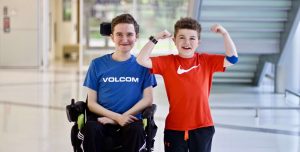What is Muscular Dystrophy?
Duchenne muscular dystrophy (DMD) is one of a spectrum of muscle diseases known as dystrophinopathies that can range from mild to severe in presentation. DMD is a genetic disorder caused by a change in the DNA that codes for dystrophin-, a protein that acts as the glue that holds muscles together and the shock absorber that allows the muscles to contract and relax without being damaged. Without dystrophin, the muscles are not able to function or repair themselves properly with normal day-to day activity. As the dystrophin gene is found on the X-chromosome, this disease primarily affects males.
Common Signs and Symptoms:
This disease is typically diagnosed between the ages two and five, normally after delays in early milestones such as sitting, crawling, walking etc. Speech delay or the inability to keep up with peers are also the first signs. As children get older, (around 6 to 9 years), more symptoms appear. Children this age typically begin to have trouble walking due to the quadricep muscles progressively getting weaker. Because of this, this impacts their balance as they attempt to shift their weight and walk. Weak core and trunk musculature are also seen, which also causes gait changes and poor movement mechanics. Due to how easily the muscles are damaged and their slow recovery, the child will fatigue faster when completing daily activities (such as walking long distances and may need a mobility scooter) and can have increased muscle soreness and weakness the day after.
How does exercise help?
For young people with Duchenne Muscular Dystrophy, having an individualised exercise program is vital to maintain strength, mobility and balance so the child can maintain their function for as long as possible. In addition, it is useful in preventing and managing pain that the child may have.
When it comes to exercises for these children, a modified physical activity program is ideal. These type of modified physical activities can be designed as fun games or skill-based activities that is kept at a low intensity and includes multiple rest breaks. This type of exercise is preferred over resistance training exercises, as they can further damage weak muscles. Game or skill-based exercises that include ball throwing or kicking are important for the child, as it keeps the muscles active and they will feel like they are building the same skills as other children, making it more fulfilling and engaging for them.
Furthermore, swimming is another great exercise option, as not having to fight against gravity allows the individual to use more strength to propel themselves and it improves their pulmonary system, while the load placed on the muscles is quite minimal. To maintain mobility and to prevent contractures, it is highly recommended to include stretching, range of motion exercises, muscle cramp massages etc as part of their routine. Incorporating stretching is vital, as because of the weakening of the muscles, exertion can lead to tightening of muscles and shortening of tendons, resulting in further loss of mobility.
For more information on Duchene Muscular Dystrophy and the role that exercise plays in their life, follow the link below.




